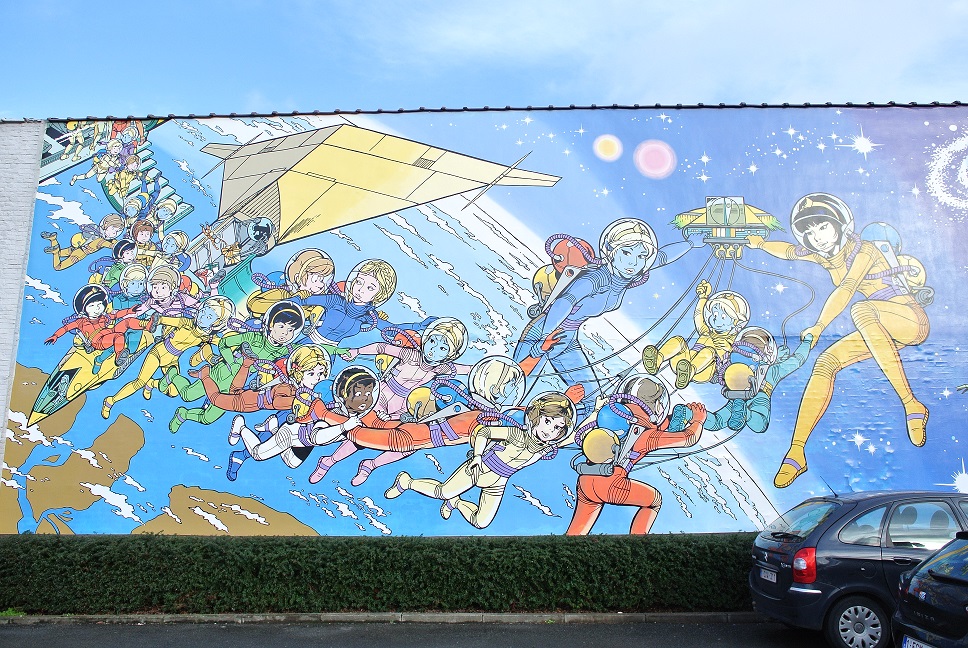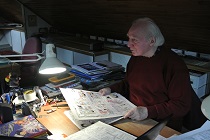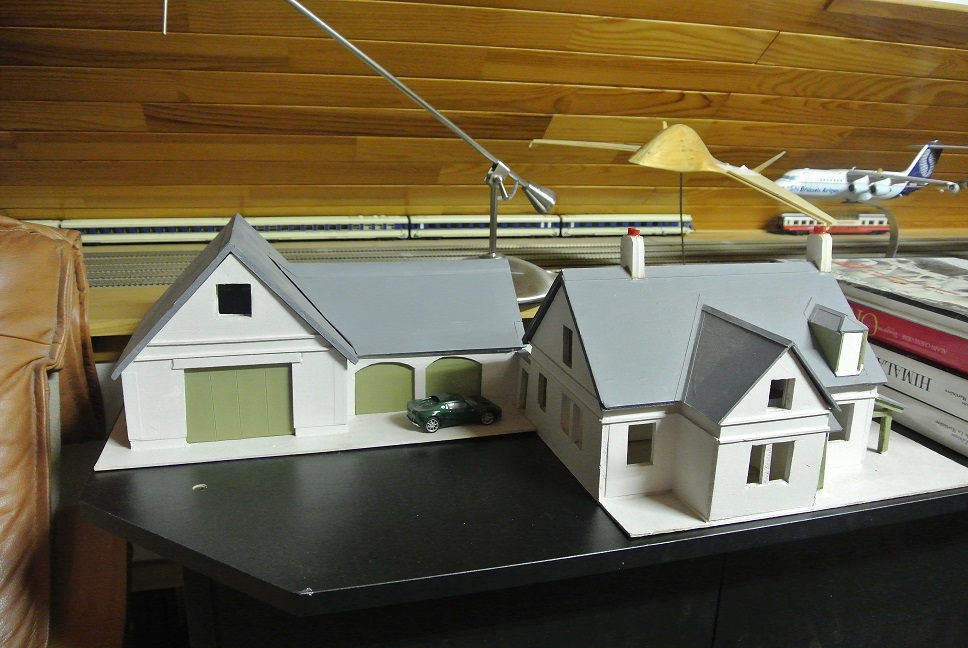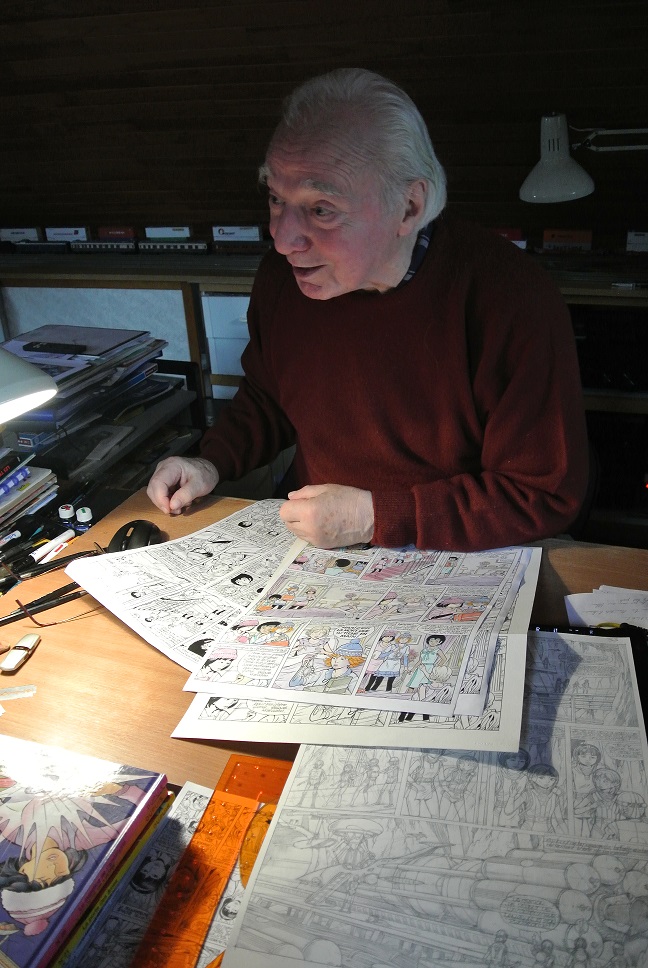

Saturday, December 28, 2013.
Just after the Christmas period, we headed to Waver in family (the Base Camp of Roger Leloup)
for a first long-awaited meeting with the author of the comic Yoko Tsuno.
We stop first in the center of Waver, where we can admire a beautiful fresco of Yoko Tsuno in space.
Then, at 2 o'clock, we knock on the door of Mr. Leloup. It was his wife who welcomed us.
I was immediately impressed by the elegance of the woman such nice hairstyle,
that we can say that she's coming straight out of a page of Yoko Tsuno.
Two Yorkies and a Scottish terrier full of passion quickly find playmates with our children.
We are invited to enter by Roger Leloup himself with the same enthusiasm.
As we enter in the house, he looks fondly his wife and confesses
"I would not have been able to do anything without her."
In 1986, I was 10 when I discovered during an afternoon at my cousins of a comic style that was totally foreign to me, completely different from what I knew as Bob and Bobette and Neron. The first story that I have read was: The prey and the ghost (number 12). I was immediately captivated by the beautiful drawings that seemed so alive and this intriguing Asian woman on the cover. I devoured this story and I immediately chained to the number 7, On the edge of the life, which left me, like many other readers, an almost mystical impression. The story is very fascinating, dealing with life and death, and takes place in a small German town, Rothenburg ob der Tauber, in a romantic setting of very old cottages mixed with futuristic machines. In a word: fabulous ...
The first Belgian fansite
In the pre-computer period without iPhones or digitally made, I was requesting a Yoko Tsuno comic as Christmas/Birthday present. So I could read stories when I wanted. When, 10 years later, in 1997, I had to create a website for my final assignment, Yoko came back to my mind. This may seem unlikely today, but at the time there was almost no data about this comic on the web. So I decided to create myself a site that would be dedicated to the serie. This is how www.yokotsuno.be has been created. This put me in touch with Roger Leloup for obtaining permissions, which he gave me willingly.
Correspondence was done via letters, emails was too new. Each letter I received from Mr. Leloup have put a smile on my face. Meanwhile, life went quickly, yokotsuno.be website grew quickly, and I created a family and I had two children. Now, many years later, my children have grown up, I finnaly decided to meet up with Mr. Leloup. Something that i didn't do before due to my limited knowledge of the French language, but with the help of my husband, who speaks better French than me, that day has finally arrived. So here we are on Dec. 28 in the living room of Mr. Leloup with his dogs that turn around us...
Hairstyles and trains
 Leloup : "my dogs, Mosquito and Whiskey, are the models for the dogs in my stories.
Newton, the black Scottish Terrier was first drawn, then we decided with my wife to buy one
that we named like in the comic."
Leloup : "my dogs, Mosquito and Whiskey, are the models for the dogs in my stories.
Newton, the black Scottish Terrier was first drawn, then we decided with my wife to buy one
that we named like in the comic."
"Follow me", said Leloup, We go up the stairs and get into his study where Yoko came to life.
A office, drawings of Yoko spread on the walls, a short passage alongside which run a model train tracks brings
us to his real workspace. This floor seems dedicated only to Yoko and trains. A railway runs across the full width of
the house, groing through a hole in the wall to end in an impressive network. Proud as a boy he switches it on.
Leloup : "I built it myself! I wish I could have brought it downstairs but my wife didn't agree (laughs).
Sometimes, when the trains are running, I sit into the armchair and get the impression to be in a train.
It makes me asleep (laughs)...
Why this fascination for trains? As a child I lived near a train yard. I could spend hours watching locomotives,
sometimes I could load coal. After such days I would get home with blackened face. They didn't like me coming
back so filthy (laughs)."
Trains play a major role in several stories, such as The Rheingold Express (No. 19).
 In the work attic, we discover some beautiful classical dolls. One resembles Yoko, the other has long blonde hair.
Leloup : "Dolls help be draw hairstyles. The blonde one, for instance, helps me with Mieke's hair (see No. 20,
The Astrologer from Bruges). That I carefully work out hairstyles for my characters has a reason:
my father was a hairdresser. When I was a young man, I used to help at the salon. Unfortunately I didn't
handle young ladies but was washing hair of elder ones (laughs).
Thanks to my father's work I particularly value the neat and beautiful appearance of my characters.
My parents were not wealthy, but they always ensured that there was food on the table. We could even
travel a little, which was not obvious at the time. I'm very grateful to them for that."
In the work attic, we discover some beautiful classical dolls. One resembles Yoko, the other has long blonde hair.
Leloup : "Dolls help be draw hairstyles. The blonde one, for instance, helps me with Mieke's hair (see No. 20,
The Astrologer from Bruges). That I carefully work out hairstyles for my characters has a reason:
my father was a hairdresser. When I was a young man, I used to help at the salon. Unfortunately I didn't
handle young ladies but was washing hair of elder ones (laughs).
Thanks to my father's work I particularly value the neat and beautiful appearance of my characters.
My parents were not wealthy, but they always ensured that there was food on the table. We could even
travel a little, which was not obvious at the time. I'm very grateful to them for that."
Leloup : "I remember the Second World War very well, as it started when I was 7. The tension that hung during
air raids, the red colour of the sky... All that gave me a new fascination for planes. They play an important
part in Yoko' stories."
Roger Leloup shows us a model of Yoko Tsuno's plane that he created and built himself.
"I like to let model planes fly, it attracts large birds that circle arround them and sometime try
to pick at them!"
But back to the beginning.
Yoko Tsuno
Roger Leloup was born on November the 17th, 1933 in Verviers. He started to draw from his 6th.
He got his first comic at the age of 10, and was fascinated by Jules Vernes stories amongs others.
After high school, he went ont to study applied arts at the Saint Luc de Verviers institute in Liège.
In 1950, he met Jacques Martin, the author of the Alix comic, and they soon started to work together.
Thanks to Martin, he encountered the Belgian master Hergé, and for 15 years, he did technical drawings
for Tintin, such as sets or vehicles, but never characters.
Leloup : "There are different opinion on Hergé, but as for myself I liked working with him.
He tought me professionalism, that is to be well documented and work out all the details."
During the 60s, there was less work at Hergé's studio so Roger Leloup worked with Peyo on some albums of
"The Smurfs" or "Jacky and Célestin". During that period, he had and idea of a Japanese character for the
later comic. When Jacky and Célestin was discontinued, Roger Leloup replaced the two main characters
with two new ones: Pol Pitron and Vic Vidéo.
The duo was completed by a young Japanese lady, Yoko Tsuno,
which will soon take centre stage and give her name to the series. As of December the 31st, 1969, Roger Leloup
left Hergé's studios to work full time on his own series, Yoko Tsuno.
Leloup : "Hergé told me: 'don't do a comic with a woman as its main character, it won't work. You can
always come back to me if it does not succeed.', but he was wrong.
For Yoko's character I was inspired by Japanese actress Yoko Tani. The name Tsuno is a place in the south of Japan."
Models
 Now, so many years and 26 albums later (the 27th is in progress), Roger Leloup still works alone with his beloved
Yoko Tsuno. He explains how he works.
Now, so many years and 26 albums later (the 27th is in progress), Roger Leloup still works alone with his beloved
Yoko Tsuno. He explains how he works.
Leloup : "I first write the script on my computer. I imagine the locations at the same time and get
any material for real locations. I also create models if it helps for my drawings. I have many in my attic,
like Yoko's cottage that you have here. That way my drawing are more precise and realistic. As you can see,
Yoko and Vic sleep separately." Even the Chinese pagoda of the "Pagoda of the Mists" (No. 23) was completely
modeled and is shown in his studio.
After this phase, he begins to draw with pencil and in large scale. Once the page is done, he makes a
photocopy of it then goes on with inking the drawings.
Leloup : "I isn't easy to freehandly ink as you can make no mistake. When this stage is completed,
again I do a photocopy then start colouring. The whole comic is coloured with crayons then the draft is
sent to Studio Leonardo. They do the final colouring on computer based on my colouring hints.
Then the publisher, Dupuis, handles printing and distribution."
Thanks to his travels to Bali, China, Switzerland, Scotland, Japan,... Roger Leloup finds inspiration
for his stories, though it often comes from Germany."
Leloup : "I did my military service in Germany. Therefore, it is only a small effort to imagine stories
located there. Now that I am older I don't feel the need for all those travels. I'm feeling well in Wavre,
it is quiet, I enjoy my garden and the birds flying around. Yoko' space travel is, on the contrary,
more difficult to draw as I need to invent it all in my head."
Future
Those who read Yoko's comic have already noticed that since the "Seventh Code" (No. 24) a new character
is taking an important place in the series: the fourteen-year-old Emilia.
Leloup : "Yoko is my daughter and Emilia my granddaughter. Emilia is a child of this age.
She is brutal, somtiems even a bit arrogant, but she has her heart in the right place. Like Yoko,
she stands firmly on her legs and likes flying. I briefly thought of stopping writing stories, but
Emilia gave me the strenght and courage to continue."
Throughout the afternoon, it strikes us that Roger Leloup really loves his characters.
They have becomed another family for him. He speaks with great love and passion for his life's work, but is also a bit worried
about the future.
Leloup : "Last year, I fell from four meters high on my back while cherry picking. I've been lucky
to recover well from it. I have arthrosis that hurts by the knee. Unlike Yoko, I am getting older, unfortunately."
However, even though he celebrated his eigthtieth birthday recently, we saw this afternoon a man full of
energy, joking with twinkling eyes. A man who works with computers, flight simulators and tablets.
But above all, a very interesting, loving and pleasant man, a man who still want to much.
Leloup : "Well, apparently I have the reputation of being an easy person but that is not so.
As I want to spend as much time possible drawing comics, I think that everything else is a waste of time.
Going to signs or to events, it is nice, but but I prefer to spend my time finishing a story.
Because of I say no to these, I get the reputation to be a solitary man. In comics you are not rich.
I work 70 hours a week, it is a lot of hard work. You have to do it with your heart. We don't often go to
the restaurant but we live correctly and do what we want."
The popularity of the comic is reflected in the many letters and email that Roger Leloup receives.
He proudly shows us a pack of fan letters. The letters come from everywhere, from home and abroad.
Leloup : "Yes I get a lot of letters from Flemings. Pity I don't speak the language. We lived close
to the German border, so I learned German, but I am very happy to have Dutch speaking fans.
I appreciate their letters that are always very friendly."
 One of the dogs comes up stairs.
One of the dogs comes up stairs.
Leloup : "You're not allowed here, aren't you (laughts)."
Leloup's wife comes up to get the dog and brings biscuits and tea. So concludes a wonderful afternoon.
Roger Leloup walks us back to our car. It is already dark, he thanked us for the afternoon, but it is mostly
us who want to thank him.
Thank you very much Roger Leloup to make us dream with Yoko Tsuno to other worlds, to let us see our
planet from a different angle, and thus to better appreciate it, to open our mind to science and technics,
to show Yoko's character as a model and to learn to respect others.
Ilse Coppieters
www.yokotsuno.be
Copyright Ilse Coppieters, Roger Leloup 2014. All rights reserved.
No modification without prior permission.